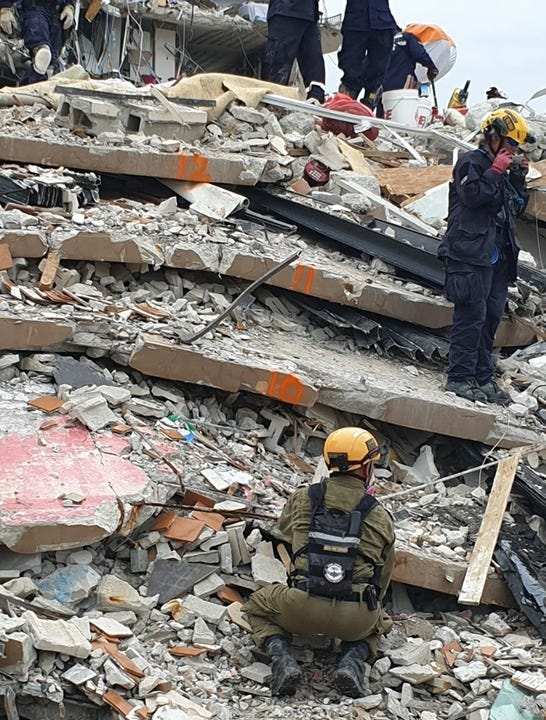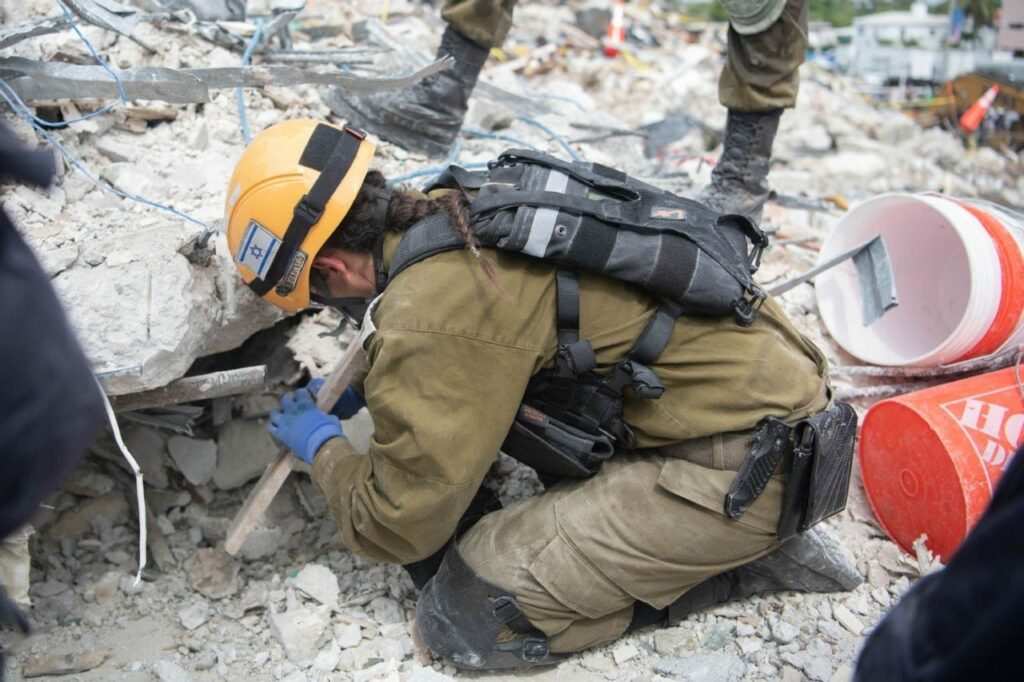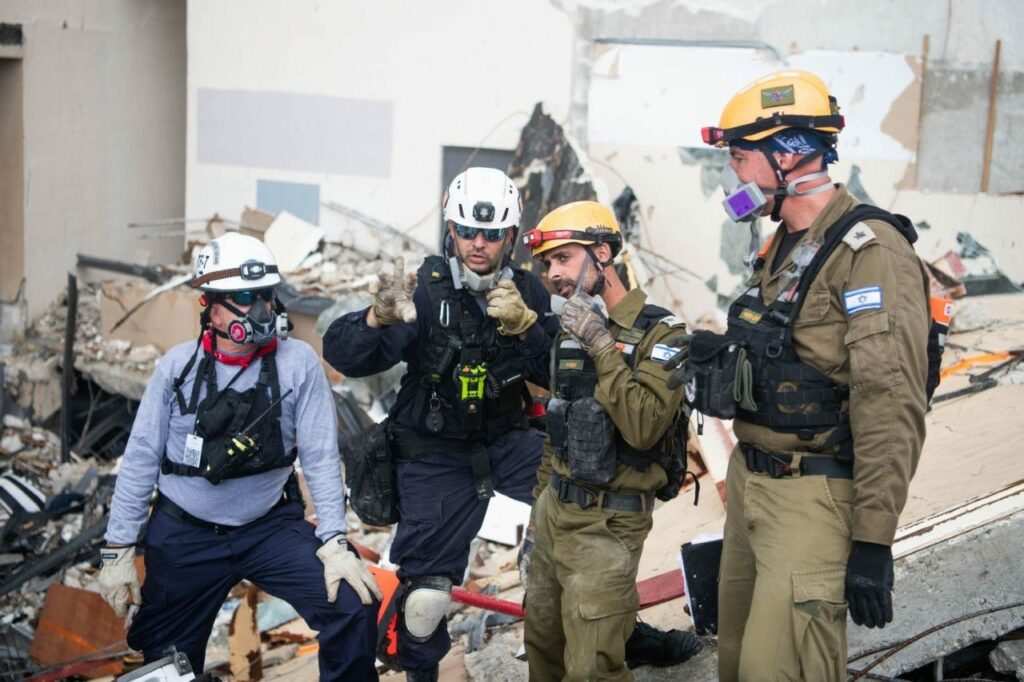When Lt. Col. Golan Vach, commander of the Israeli Defense Forces’ National Rescue Unit, located a man’s ring while searching the debris field of the collapsed Champlain Towers South in Surfside, he knew immediately to whom it belonged.
He knew, because he had met with families of the scores of missing people. He had studied photographs of the missing, learned about their possessions — a necklace with a heart pendant, a gold watch, a blue table.
He had learned about the habits of each potential victim and even knew in which room each likely would have been during the collapse.

And, amid unimaginable tangles of rebar jutting out from a sea of concrete that was once their homes, he knew precisely where each victim would be located.
He personally found 20. His team, he said, helped the U.S. rescue teams that found another 81 victims by the time the last IDF member departed Surfside on July 11. As of Friday, July 23, 97 people in all had been recovered.
“This is the way we were working, like detectives,” Vach said. “You have these stupid, simple, brilliant signs. You dig here, and you will find the people you are looking for. And it worked.”
In a series of exclusive, in-depth phone calls, emails and video chats from his home in Beit Rimon — located about 15 miles west of the Sea of Galilee in northern Israel — Vach described the integral role the Israeli Defense Forces (IDF) played in recovering victims from the partially collapsed, 13-story, 136-unit condominium complex.

At the heart of the effort, Vach said, was the cooperation and teamwork the crews on the site displayed. Vach said he learned a lot from the Miami-Dade, Florida and U.S. rescue teams already on site when the IDF squad arrived.
“We admired their professionalism, commitment and determination to complete the task at a cost,” he said, also lauding the leadership of Miami-Dade County Mayor Daniella Levine Cava and Surfside Mayor Charles Burkett.
Rubble to untrained eye, each piece was part of a puzzle that led to victims
What the untrained eye saw as a pile of rubble the IDF team viewed as a building in puzzle form. And each piece, whether a stone column, slab of concrete, or crushed family heirloom, pointed them toward where a victim might be found.
Sadly, their success would not result in anyone’s rescue, but rather in bringing closure and solace to grieving loved ones and providing them an opportunity to say goodbye and begin to heal their broken hearts.
Vach related how, within hours of receiving approval from the U.S. to join the rescue efforts, his team boarded a commercial flight to Miami.
On the plane were 15 of his delegation’s “best people,” Vach said. They arrived at 8 a.m. on Sunday, June 27, the morning of the fourth day of rescue efforts. And while they were not scheduled to begin work until noon, he said, the team headed straight to the collapse site.

“It’s like a race where most of the runners began a few seconds ahead and you are trying to catch them,” he said. “After 72 hours, we had to work very tight, very hard, to be onsite 24/7 to try to find out if there are still signs of a living person.”
The first thing Vach did, he said, was request a list of missing persons. But he said authorities told him they could not release that information.
The search for family members of the missing to gain valuable information
Knowing precise and meticulous details provided by family members would be crucial to rescue efforts, members of Vach’s team immediately began the task of searching out parents, siblings, adult children, cousins and other loved ones stuck in agonizing wait for word on rescue efforts.
“I know from experience that each hour is expensive in those kinds of incidents,” Vach said.
They found many families staying in the same hotel where the IDF team was housed. In only six to eight hours, he recalled, one of his team members came to him with what she determined would be the number of people for whom they should be searching. But that number didn’t match the one put out by U.S. authorities.

“I said, ‘But the official numbers are 159. How come you have only 98?'” Vach said. “And she said, ‘This is it. There will be no more than 98 or 99. Not a single one more.'”
As of Friday, 97 victims had been identified, reported Miami-Dade Police, with one more categorized as “potentially missing.”
Red triangles: Finding victims using a formula honed over almost 40 years
While half of Vach’s team met with victims’ families, the other half deployed to the rubble pile, Vach said. There, they found first responders digging in areas where search dogs were barking.
Based on vast experience, Vach said, he believed the rescuers would need a “much wider methodology to try to evaluate where exactly people were buried in the site.”
His team did not use dogs, he said, but rather a formula that had been honed over almost 40 years. It was expertise developed from responder missions in wars and catastrophic events in Israel and around the world, including in Lebanon, Cyprus, Haiti, Japan, Mexico, Egypt, Honduras and India. The team had even been on hand to assist during Hurricane Katrina when it flooded and devastated New Orleans in 2005.

So, like attempting to solve the most gruesome of puzzles, Vach’s team poured its sweeping knowledge into studying the pile of concrete, rebar and assorted building materials along with victims’ consumer goods and personal possessions.
The team also amassed what Vach called “field rescue intelligence,” which included collaborating with other first responders.
They identified dividing lines between floors, determined where columns intersected units and where hallways once linked neighbor to neighbor.
3D computer models: Dark red spot showed where victim should be found
With help from his team back in Israel, Vach’s group developed 2-D and 3-D computer models to determine how the building had fallen and where there might be “voids” or crevices that could support life.

The result was a series of digital images that showed precisely where each room was located both before and after the collapse: red for bedrooms, blue for dining rooms, green for kitchens, yellow for corridors. A dark red triangle marked the spot where a victim should be found.
The team marked each column, each room, each floor in the pile. Orange spray paint and red brick — that was the ninth floor. Blue spray paint segregated the entire debris field into a grid.
The team created a “fragile reality,” calculating and mapping how far one victim might have landed from another. That way, rescuers could search with purpose, measuring out the distance and direction — 13 feet to the west, 33½ feet to the south, 29 feet to the east — from each victim to where another might be found.
And so continued the meticulous process of diagramming the site. With each person or personal item recovered and identified, the team confirmed or modified their model.
“Each item that they found is an anchor to correct the plan,” Vach said. “If I assume I am on Floor 4 in apartment 404, but I found a blue table, and I know the blue table belonged to Apartment 3, not 4, then something is incorrect, something moved. And I have to correct my plan.”

Once, he said, another rescuer found a deceased dog and was about to discard it.
“I said, “No, no stop!'” Vach said. “Look at this building — according to what we know there were only two dogs. One was a pit bull and one was a big gray dog. Each dog belonged to a different apartment. If we know exactly where you found this dog, we can try to correct our plan.”
Finding the 7-year-old, near the body of her mother and grandparents
Vach seemed to know every unit number, every resident of Champlain Towers South. At the mention of either, he can identify the other. Unit 1104, Itty and Tzvi Ainsworth. Parents to seven, grandparents to 30.
“When I sat with the Ainsworth family, they were the only family that I described in detail how I found them, extracted them, pulled them out,” he said. “It’s not easy.”
Vach recovered Stella Cattarossi, the 7-year-old daughter of a Miami-Dade firefighter who was also part of the search-and-rescue team. The child was near the body of her mother and grandparents, who lived in unit 501.

Two other victims were located with the help of his team back in Israel, Vach said, after he found a tiny plaque that read “Rabbi A. D. Davis.” It was around 4 a.m., Vach recalled, and within 20 minutes, his team had located the rabbi, who was not in the building at the time but told them he knew of a person in the building.
Vach said the rabbi had given the plaque as a gift to Brad Cohen, who lived in unit 1110. “So I know I am close to Brad,” Vach said he thought at the time.
On July 7, Vach found Cohen. He also found Cohen’s brother, Gary, who was visiting from out of town.
“You see a lot of death,” Vach said. “Some do not look like human beings. I tried to treat them as people, as souls. Treat them as if they were my parents.”
Still, the heartbreak of finding someone’s loved one never gets easier, Vach said softly, and some of his team really struggled.
“I say to them, ‘Hey, it’s OK. She was waiting for us for five days to be found. Treat her gently. Cover her with a blanket. One day, you will be the same,'” he said.
Team honed its search skills because of the war zone in the Middle East
The harsh reality, said Maor Elbaz Starinsky, the consul general of Israel, is that the Israeli teams are so proficient at what they do because they have had so much opportunity to sharpen their skills.
“Unfortunately, we have a lot of experience with disasters,” he said. “Israeli towns and cities and population centers have become the new front for the war zone in the Middle East. …
So our military and authorities have developed very advanced techniques that are useful in territories other than war zones.”
While Starinsky already had 15 years’ experience in the foreign ministry, he was only four days into his new position as Israeli consul general in Miami when Champlain Towers South collapsed, he said in a telephone interview from his home in Israel.
He said he had not been confirmed after initially accepting the position months earlier because of turmoil in the Israeli government.
“It was a really bumpy start for this whole mission,” he said, adding that the Israeli foreign minister immediately after the collapse instructed him to “spare no effort” in assisting.
“For us, the most natural thing still is, and forever will be, to offer our help to our biggest ally,” he said. “Israel will never have a better friend than the U.S., and the U.S. will never have a better ally or friend than Israel.”
Israeli team has fewer members so they learn to be ‘small and swift’
Starinsky said he provided his personal credit card to help fill prescriptions and buy blankets, shoes and food for those who had survived the collapse but lost all of their possessions.
His team also helped family members of the missing arrange travel from places such as Israel, Venezuela and Colombia, he said, and the Israeli Embassy in Washington helped them even further when they arrived in Miami.
“This is not a Jewish tragedy, this is a human tragedy, it’s an international tragedy,” he said.
Starinsky said that while U.S. forces vastly outnumber Israeli forces, Israeli forces have learned to do more with less.
“We have to be very, very wise and clever in the way we run our operations,” he said. “We have learned to be what we call ‘small and swift.'”
U.S. and Israeli teams complemented one another beautifully, he said, each drawing on their greatest strengths to do everything possible to rescue and recover victims from what he called a “very dramatic,” “violent” collapse.
Do Israelis think lives could have been saved if they had arrived earlier?
And while some have questioned if more lives could have been saved if the IDF team had been brought in sooner, Starinsky is not so sure.
“Maybe, maybe, maybe,” he said slowly, contemplating the question. “It took us a few days to prove our uniqueness, our efficiency; why it was worth schlepping us, commuting us, from halfway across the world to help the U.S.”
Still, after thinking about it, he said he doesn’t think it would have made much difference.
“Probably, because of the nature of this collapse, everybody died instantly or very close to instantly,” he said. “I’m not sure if we had the coordination earlier it would change the result of this disaster.”
The primary reason for that, he said, was the way the building collapsed was so unusual.
“It was not like an earthquake or urban missiles when part of the building is broken or falls down and you have a lot of voids and holes and tunnels that are created,” he said. “This building collapsed almost as if it was intended. When they imploded the other part, it imploded in the perfect shape.”
Then, he paused for a moment, clearly shaken by the memory, before adding almost under his breath, “It’s a terrible word to say, ‘perfect.'”
___
© 2021 www.palmbeachpost.com
Distributed by Tribune Content Agency, LLC.



